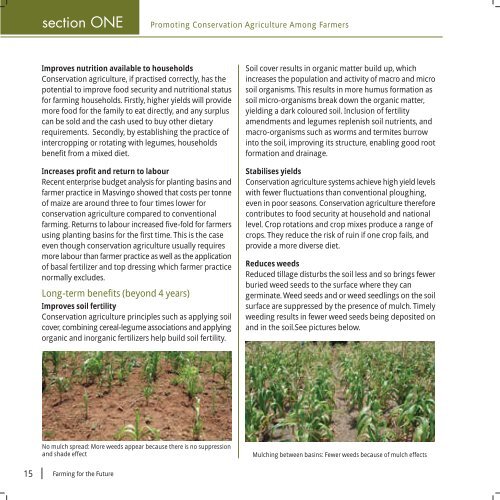A Guide to Conservation Agriculture in Zimbabwe - Canadian ...
A Guide to Conservation Agriculture in Zimbabwe - Canadian ...
A Guide to Conservation Agriculture in Zimbabwe - Canadian ...
You also want an ePaper? Increase the reach of your titles
YUMPU automatically turns print PDFs into web optimized ePapers that Google loves.
section ONE<br />
Promot<strong>in</strong>g <strong>Conservation</strong> <strong>Agriculture</strong> Among Farmers<br />
Improves nutrition available <strong>to</strong> households<br />
<strong>Conservation</strong> agriculture, if practised correctly, has the<br />
potential <strong>to</strong> improve food security and nutritional status<br />
for farm<strong>in</strong>g households. Firstly, higher yields will provide<br />
more food for the family <strong>to</strong> eat directly, and any surplus<br />
can be sold and the cash used <strong>to</strong> buy other dietary<br />
requirements. Secondly, by establish<strong>in</strong>g the practice of<br />
<strong>in</strong>tercropp<strong>in</strong>g or rotat<strong>in</strong>g with legumes, households<br />
benefit from a mixed diet.<br />
Increases profit and return <strong>to</strong> labour<br />
Recent enterprise budget analysis for plant<strong>in</strong>g bas<strong>in</strong>s and<br />
farmer practice <strong>in</strong> Masv<strong>in</strong>go showed that costs per <strong>to</strong>nne<br />
of maize are around three <strong>to</strong> four times lower for<br />
conservation agriculture compared <strong>to</strong> conventional<br />
farm<strong>in</strong>g. Returns <strong>to</strong> labour <strong>in</strong>creased five-fold for farmers<br />
us<strong>in</strong>g plant<strong>in</strong>g bas<strong>in</strong>s for the first time. This is the case<br />
even though conservation agriculture usually requires<br />
more labour than farmer practice as well as the application<br />
of basal fertilizer and <strong>to</strong>p dress<strong>in</strong>g which farmer practice<br />
normally excludes.<br />
Long-term benefits (beyond 4 years)<br />
Improves soil fertility<br />
<strong>Conservation</strong> agriculture pr<strong>in</strong>ciples such as apply<strong>in</strong>g soil<br />
cover, comb<strong>in</strong><strong>in</strong>g cereal-legume associations and apply<strong>in</strong>g<br />
organic and <strong>in</strong>organic fertilizers help build soil fertility.<br />
Soil cover results <strong>in</strong> organic matter build up, which<br />
<strong>in</strong>creases the population and activity of macro and micro<br />
soil organisms. This results <strong>in</strong> more humus formation as<br />
soil micro-organisms break down the organic matter,<br />
yield<strong>in</strong>g a dark coloured soil. Inclusion of fertility<br />
amendments and legumes replenish soil nutrients, and<br />
macro-organisms such as worms and termites burrow<br />
<strong>in</strong><strong>to</strong> the soil, improv<strong>in</strong>g its structure, enabl<strong>in</strong>g good root<br />
formation and dra<strong>in</strong>age.<br />
Stabilises yields<br />
<strong>Conservation</strong> agriculture systems achieve high yield levels<br />
with fewer fluctuations than conventional plough<strong>in</strong>g,<br />
even <strong>in</strong> poor seasons. <strong>Conservation</strong> agriculture therefore<br />
contributes <strong>to</strong> food security at household and national<br />
level. Crop rotations and crop mixes produce a range of<br />
crops. They reduce the risk of ru<strong>in</strong> if one crop fails, and<br />
provide a more diverse diet.<br />
Reduces weeds<br />
Reduced tillage disturbs the soil less and so br<strong>in</strong>gs fewer<br />
buried weed seeds <strong>to</strong> the surface where they can<br />
germ<strong>in</strong>ate. Weed seeds and or weed seedl<strong>in</strong>gs on the soil<br />
surface are suppressed by the presence of mulch. Timely<br />
weed<strong>in</strong>g results <strong>in</strong> fewer weed seeds be<strong>in</strong>g deposited on<br />
and <strong>in</strong> the soil.See pictures below.<br />
No mulch spread: More weeds appear because there is no suppression<br />
and shade effect<br />
Mulch<strong>in</strong>g between bas<strong>in</strong>s: Fewer weeds because of mulch effects<br />
15 Farm<strong>in</strong>g for the Future
















